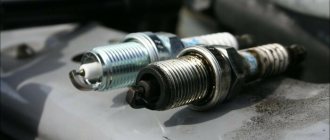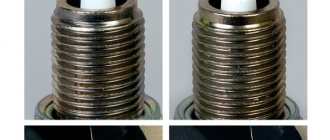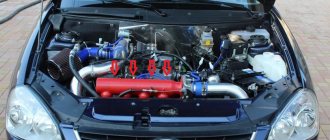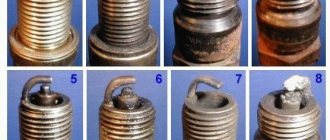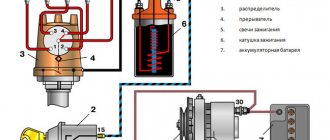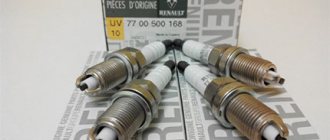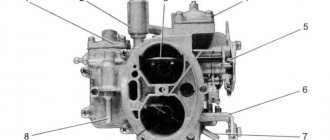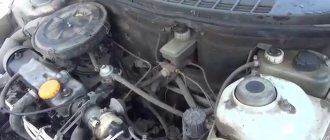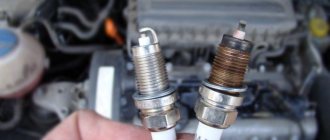When plugs are filled in on an injection engine, problems usually arise with starting it. For example, in the evening you returned from work, parked your car and calmly went home.
Morning comes, you need to go to work, but the car refuses to start. And the starter turns, but there are no signs of even attempts to ignite the fuel composition.
Therefore, a modern car enthusiast must be prepared for any surprises and be able to react to them correctly.
By the way, this phenomenon is typical for any type of fuel system (carburetor, injection - it doesn’t matter).
In most cases, trouble occurs in winter, when it is frosty outside. In the warm season, fuel filling the spark plugs on the injector occurs much less frequently.
So what to do?
Main reasons
First, let's look at the main reasons for this phenomenon. Surprisingly, the main source of problems in this case is the car’s ECU and the features of its firmware.
When it’s below zero outside, the system tries to create certain conditions for the fuel mixture. It is no secret that in frosty air the volume of oxygen is much higher.
So it turns out that the ECU sends an order to the injectors to supply a larger volume of fuel.
Naturally, “orders are not discussed” and the injectors increase the amount of gasoline injected.
READ ON THE TOPIC - The principle of operation of the injector.
Studying plaque on candles
They say that when candles are “flooded,” black soot forms. Let us clarify: it should not consist of inclusions. All metal, in turn, will be covered with an oily coating. Dry carbon looks different...
Oily layer and dry soot
The photo shows two cases. “Our version” is on the right.
We recommend: Getting the salon in order: 3 services
And soot can also be brown. And it always, in 100% of cases, is formed due to flooding with gasoline.
Dark brown soot
An oily coating, as in photo 1, is, nevertheless, the result of oil ingress. But an oiled candle does not work correctly - it will also be “flooded”.
With regular “flooding,” carbon deposits form, which we see in photo 1 on the right and in photo 2. The rest does not apply to our case.
What's next?
The battery experiences enormous stress in the cold and may not produce the required voltage level (and there is no guarantee that it is new).
You turn the ignition key, the injectors deliver the required volume of gasoline into the combustion chamber, and the starter does its best to turn the crankshaft and create a sufficient level of compression in the engine.
At the same time, the candle is also trying to work.
Everything is true, but the quality of domestic fuel is far from being at the best level.
At the same time, in cold conditions (and not even in a new car), it is not always possible to achieve ideal compression.
The injectors have done their job, the spark plugs produce a spark “every once in a while”, and the compression level is too low. The result is flooded candles.
Why are the candles wet?
Sometimes a removed spark plug may be wet. This may be caused by gasoline, oil or coolant (antifreeze). Each of these liquids has its own determination methods.
We recommend: We wash the hydraulic compensators yourself
Gasoline can be easily identified by its high volatility. By unscrewing the spark plug, the gasoline quickly dries out. Most often, filling with gasoline occurs when starting a cold engine. This can also happen due to incorrect ignition adjustment.
Oil on the spark plug electrodes may appear due to significant wear of the oil seals in the valves. Less commonly, the cause may be wear of the engine cylinder-piston group or breakage of the oil rings on the piston. Any of these faults requires immediate repair.
The amount of oil on the spark plugs can indicate how serious the problem is. When diagnosing, it is best to use a set of new spark plugs recommended by the car manufacturer, since droplets of oil are clearly visible on a clean insulator. The first stage is the appearance of small dark spots from burnt oil. This will not affect the performance of the spark plug in any way, but will indicate that there are still problems with the engine. The next stage of oil entering the combustion chamber will be the moistening of the lower threaded part of the spark plug. This condition of the spark plug will cause popping noises in the muffler at idle. They disappear as the engine speed increases.
Next is coating the end of the threaded part of the spark plug with oil. In this case, a spark may not appear. The result is frequent claps in the muffler.
The last stage is the complete wetting of the candle from below. In this situation, a spark does not form at all. Therefore, a cylinder with such a spark plug does not work. You can find out about this by regular claps in the muffler, which do not stop with increasing speed. The engine starts to stall.
If oil enters the combustion chamber with completely working fuel supply and ignition systems, then its combustion occurs on the electrodes of the spark plug. As a result, the oil does not have time to wet the candle. That's not to say it's good, but it's not too bad either. In this case, droplets of burned oil turn into ash. It accumulates on the electrodes, increasing their thickness. When the engine is running, the ash warms up well. This promotes further combustion of the incoming oil. It is easy to clean, but it is better to do this at the same time as replacing the valve seals. If you remove the ash from the candle, the oil may stop burning. Because of this, the spark may stop jumping, the spark plug will flood, and the cylinder will stop working.
Sometimes “traditional craftsmen” use the following methods to combat flooding of candles: install candles with a shorter skirt or with a higher heat rating, increase the spark voltage by putting on high-voltage tips, leaving a small gap. All these methods are short-lived, ineffective, and are dangerous for the condition of the car.
The reasons for the ingress of coolant may be the following: a poorly pressed cylinder head, a crack in it or in the liner body, a leaky carburetor heating system. As for the last reason, it is typical only for Japanese cars.
In practice, it is difficult to determine whether antifreeze enters the combustion chamber, since when the engine warms up, some holes may close as a result of metal expansion. Diagnostics must be carried out on a cold engine. To do this, you need to start the car for about 10 seconds. During this time, the candles will not have time to heat up and the cracks will not disappear. When the spark plug is removed, the coolant looks like dew drops.
When buying new spark plugs, you should be wary of counterfeits, as they can cause the entire engine to fail. They can be identified by a crooked or uneven inscription, poor-quality processing of the hexagon of the candle, or poorly executed packaging.
What to do in this case?
Press the accelerator pedal all the way and turn the key in the ignition.
Crank the starter for 8-10 seconds. At the end of this time, the pedal can be returned to its original position.
In most cases, the engine starts.
The peculiarity of this method is that when the gas is fully pressed, the fuel supply to the engine is shut off, and the spark plugs themselves are blown exclusively with air.
If the engine still does not start, then you need to dry the spark plugs.
What to do if the spark plugs are flooded and how to start the car?
Replacing spark plugs
How to understand what has flooded the candles? By unscrewing them from the block head, the electrodes will be covered with moisture. But if the spark plugs are flooded in winter, including on the injector (injection engine), and there is no desire to “digging” in the engine in the cold, you can “blow out” the combustion chambers.
Often, “ventilating” the combustion chambers by starting the engine and depressing the gas pedal is quite enough to dry the spark plugs.
If the spark plugs are flooded and the car won’t start, there is no point in waiting for them to dry out. It is necessary to remove excess fuel from the chambers. The procedure is simple - press the gas pedal all the way, turn the engine with the starter for 10 seconds, release the pedal and try to start the engine. Cranking the engine with the throttle valve fully open “ventilates” the combustion chambers and dries out the spark plug insulators. But this method is good in cold weather and if the battery is in perfect condition. The most sensible thing to do would be to unscrew the candles, wipe them and dry them with an open flame - possibly on a gas stove. In such a case, of course, it’s a good idea to have a spare set, even if it’s not new, but still functional. The combustion chambers can also be cleaned by cranking the engine. With the spark plugs turned out, the load on the battery is significantly less. Unscrewing the spark plugs is also good because you won’t rack your brains trying to figure out what’s wrong with the engine—whether the spark plugs are filled with gasoline or something else has happened—for example, the fuel pump has failed.
We recommend: Symptoms of a faulty crankshaft sensor or how to prevent breakdown
How to do it?
The tools you can use are a regular toothbrush (or a metal brush) and a hair dryer (for more effective drying).
If you have the opportunity to take the candles home, you can “calcinate” them in the oven or directly on the burners. But this method is only temporary.
If the candles have already expired, then it is better to simply change them.
It happens that almost every day the spark plugs on the injector are filled. In such a situation, it is necessary to carry out a full check of the elements - for the presence of spark output, cleanliness of the injectors, quality of the spark, and so on.
Interesting read: Iridium spark plugs, pros and cons.
Possible solutions to the problem of flooded candles
The manufacturing plant has already foreseen the situation in which the spark plugs splash, and VAZ, for example, has the corresponding instructions in its passport. Basic recommendations for actions if fuel gets on the spark plug, which is called “cold”:
- Remove the candles.
- Crank the starter for 15 minutes without spark plugs.
- Wipe and dry the spark plugs well, then install them in their original place.
There is an alternative, so-called “folk” method. It must be applied even before the spark plugs are removed:
- Press the gas pedal all the way.
- Crank the starter for 10 -15 seconds.
- Return the pedal to its place.
Since at this moment there is no supply of fuel mixture, the spark plugs are purged and dried with air. If all else fails, remove the wet spark plugs and dry them thoroughly. Depending on the conditions, you can dry it over any heat source - fire, gas stove, hairdryer.
Calcination shortens the life of candles, so you should not heat them for a long time. After drying, the gap must be checked; if necessary, the gap is adjusted and the spark plug is installed in its place. If everything is done correctly, the engine should start.
Injection and carburetor spark plugs are practically the same, so the methods used can be used in both cases. If the spark plugs on the injector are flooded in the warm season, diagnostics of the fuel system and the sparking mechanism is necessary. If necessary, it is necessary to replace faulty components. At the same time, the condition of the injectors is checked, as well as the functionality of the Hall sensor.
The main reasons why spark plugs flood lie in non-compliance with the terms of preventive maintenance and technical regulations. Prevention can significantly increase the period of trouble-free operation of vehicle components. Therefore, even before the onset of frost, a number of preventive measures should be carried out:
- Constantly monitor the condition of the battery. In winter, it is generally better to install a battery with a higher capacity than was used in the warm season. With a powerful battery, a number of reasons for allowing fuel to flood the spark plugs disappear. It is best to recharge the battery at night, but in compliance with fire safety rules;
- During cold weather, increased attention must be paid to engine oil, and high-quality gasoline should also be filled, without contaminants. Consumable lubricants must be appropriate for the season;
- You must constantly monitor the condition of the spark plugs. It is necessary to regularly unscrew the spark plugs, remove carbon deposits from them, clean and adjust the gap. If technical characteristics deteriorate, it is best to replace the spark plugs.
Troubles with ignition often occur in the cold season. If the car is stored open, a frosty morning can bring trouble to the car owner.
The problem can be identified by some indirect signs:
- There is rotation of the crankshaft by the starter, but there is no seizure;
- a distinct smell of gasoline spreads through the exhaust system, which is audible especially when the starter rotates;
- Having unscrewed the spark plugs, you can notice fuel residues not only on the electrodes, but also on the threads, and the underside is covered with dark soot.
There are certain features when filling spark plugs in a car with an injection power system and a carburetor, but in both cases the common feature is the presence of fuel entering the chamber and the absence of its ignition. In this case, the contacts end up in liquid, sparking does not occur, and further normal operation of the motor becomes impossible.
Experienced motorists are faced with situations when a spark appears, the starter rotates, but the lower part of the spark plugs is filled with gasoline. Do not be deluded by the presence of a fire, since this event can occur irregularly under pressure and can be lost while the engine is running.
The cause of the event appears to be excessive pressure in the cylinders. It will be possible to identify the event and the factors that motivate it by monitoring the car on a stand that simulates a combustion chamber.
We recommend paying attention to the valve timing, because their failure will be the cause of wet electrodes. In injection internal combustion engines, motorists should check the functionality of the bypass valve located on the fuel rail. If its malfunctions are ruled out, you will need to find out the gasoline pressure in the rail, because the manufacturer regulates this parameter.
Diagnostics will need to be carried out for the sensors of the electronic control system and for the injectors. An example of a failure is when the coolant temperature sensor sends incorrect data. In such a situation, the control unit unreasonably over-enriches the fuel mixture. Much less often, the culprit of incorrect impulses is a failed electronic control unit or a malfunction of its software. In this case, problems will appear not only with the ignition.
The manufacturing plant has already foreseen the situation in which the spark plugs splash, and VAZ, for example, has the corresponding instructions in its passport. Basic recommendations for actions if fuel gets on the spark plug, which is called “cold”:
- Remove the candles.
- Crank the starter for 15 minutes without spark plugs.
- Wipe and dry the spark plugs well, then install them in their original place.
Since at this moment there is no supply of fuel mixture, the spark plugs are purged and dried with air. If all else fails, remove the wet spark plugs and dry them thoroughly. Depending on the conditions, you can dry it over any heat source - fire, gas stove, hairdryer.
Injection and carburetor spark plugs are practically the same, so the methods used can be used in both cases. If the spark plugs on the injector are flooded in the warm season, diagnostics of the fuel system and the sparking mechanism is necessary. If necessary, it is necessary to replace faulty components. At the same time, the condition of the injectors is checked, as well as the functionality of the Hall sensor.
In cold weather, before starting, you must first load the battery, then disconnect it for a while. After waiting a few minutes, you can try turning the starter to start the engine. If you fail to start the car on the first try, then in order not to fill the injector, you must wait a few more minutes. If all preventive measures were carried out in full before the frost, then there should be no problems with filling fuel.
We can list several conditions that are considered optimal for normal operation of the injector:
- presence of a working starter;
- maximum battery charge. The battery is powerful and in good condition;
- seasonal lubricant is used;
- spark plugs and high voltage electrical circuits must be in perfect condition;
- clean, adjusted nozzles are installed;
- The gas tank is filled with high-quality fuel.
There is an opinion among experienced drivers that driving a car along a highway at a speed of 120 km/h promotes self-cleaning of automobile systems, including the fuel system. You can also run the engine at 5000 rpm for about 10 minutes in the morning. The effect is similar to racing on a track.
It is believed that when high pressure is created in the systems, self-cleaning occurs. These measures can only be carried out if the car is in good condition and a significant increase in pressure in the systems will not harm it.
The question arises, what to do if the car is not old, all systems are in order, but in the cold it refuses to start? When turning the spark plugs out, it turns out that they are wet. As already mentioned, in the cold season, the cause of this phenomenon may be weak compression, low-quality fuel or a weak battery.
Let's look again at the manufacturer's instructions. The book on car operation defines the following algorithm of actions:
- Turn out the spark plugs.
- Wipe them thoroughly and dry them.
- Run the starter for a few seconds.
- Put everything in place.
Often, car owners clean the injector using various fuel additives. This is not recommended at all, firstly, the quality of the fuel mixture is lost, which negatively affects the operation of the entire piston group, and secondly, the injector should be cleaned using special equipment.
Experienced drivers carry several sets of spare spark plugs with them. The quality of the spark produced depends on the technical characteristics of this ignition component. There is no point in saving on candles, their cost is not that high, and low-quality candles can cause a lot of problems.
How to act to avoid trouble
There are several recommendations that will help minimize the occurrence of such problems:
- firstly, you need to monitor the battery charge level and periodically recharge it (this is especially true in winter);
- secondly, check the serviceability of the starter and if any problems arise, do not be lazy to go for diagnostics;
- thirdly, fill the engine with only the best quality oil, which is suitable for use in winter;
- fourthly, change spark plugs in a timely manner and inspect high-voltage wires for the fact of their probable failure;
- fifthly, adjust and clean the injector nozzles. This is easy to do - add one of the special compounds that are sold in stores to the tank;
- sixth, use high quality automobile fuel. To do this, refuel at trusted gas stations.
Remember that in the cold season the engine does not like small trips at low speed.
Therefore, in order to avoid problems, it is necessary to drive 50-80 kilometers at a time at least once a month and accelerate the car to 90-110 kilometers per hour (if, of course, road conditions allow).
If this is not possible, then periodically, while driving, increase the engine speed to 4-5 thousand revolutions. This is an excellent method for removing excess deposits and carbon deposits.
It’s important to read about the reasons why the car won’t start.
We are looking for reasons why the spark plugs on the injector are flooded
Both lean and too rich mixtures cause the engine to stall. But the ECU cannot be wrong... The injectors, in turn, may be clogged - everything is clear here. And in cold weather, the valve may not close well due to ice formed.
Gasoline stain on the water
Conclusion: It is advisable to use fuel with zero water content. A carburetor filled with water may simply freeze, and each of the four (six, eight) injectors will flood the spark plugs at startup.
Main list
The main reasons why the engine floods the spark plugs include the following:
- In winter - the presence of water in gasoline;
- The evaporation coefficient must correspond to the air temperature (season). There is “summer” and “winter” gasoline. By the way, the indicated coefficient has nothing to do with the octane number;
- Clogged injectors are the reason for preparing a lean mixture;
- Slow cranking at start-up is also a common cause;
- Faulty valve stem seals contribute to the presence of oil in the combustible mixture.
When adding ferrocene additives, the second reason is aggravated. And they fight the fourth reason by moving to using the “right” oils. The material should not freeze in cold weather.
Oil 10W40 at -30 C
Recommended SAE ratios: 0W, 5W, but not 10W.
How they do it in practice
You can start a fuel-injected internal combustion engine in winter with both winter and summer fuel. It’s just that in the second case the mixture will have to be made leaner. The question is how to achieve this... For example, you can flash a “winter” program. Or do this:
- Before starting the engine, the temperature sensor is temporarily disabled. Instead, a sensor heated in the hands is put on the plug;
- We are trying to turn on the starter... The ECU “thinks” that the engine is warmed up and prepares a leaner mixture than it should.
Note that the DTOZh sensor will be attached to the thermostat.
Connector DTOZH ECU, VAZ-2114 car
We recommend: How to remove the window lifter handle?
If the number of sensors exceeds 1, disconnect the one to which two wires go. It is always connected to the ECU.
Fuel with low volatility does not combine well with cold air - the mixture turns out to be heterogeneous. But if the concentration is lowered, the problem is solved.

